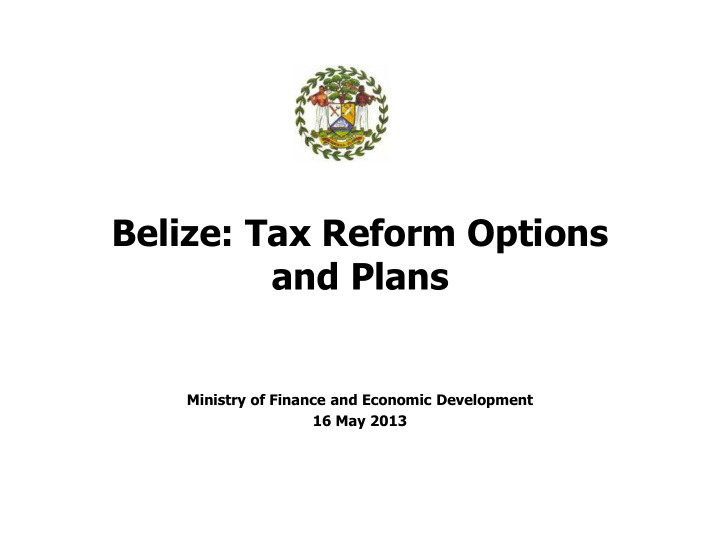



Belize: Tax Reform Options and Plans Ministry of Finance and Economic Development 16 May 2013
Outline of Presentation • Select Economic Indicators • Summary of Debt and Fiscal Situation • The Big Question is What Steps and How Soon • Potential Areas for Reform • Conclusion
Select Economic Indicators: Key Indicators for 2012 Output Growth 5.3 % Average Inflation 1.4% External Current Account 1.7% of GDP Primary Surplus (FY2012-2013) 1.2 % of GDP Overall Deficit (FY2012-2013) - 0.6 % of GDP Public and Publicly Guaranteed Debt 78.6 % of GDP o/w External Debt 66.4 % GDP Debt Service (in percent current revenue) 22.9 %
Select Economic Indicators: Central Government’s Operations for FY 2012-2013 (in Percent of GDP) Revenue and Grants 26.1 Revenue 25.0 Of which: Non-Oil Revenue 23.6 Petroleum Operations 1.0 Capital Revenue 0.1 Grants 1.0 Current Expenditure 22.0 Capital Expenditure and Net Lending 4.6
Select Economic Indicators: Main Components of Current Revenue FY 2012-2013 (in percent of GDP) Taxes on Income and Profits 7.1 Taxes on Property 0.2 Taxes on International Trade 6.2 Taxes on Goods, Transactions and Services 8.6 Other Taxes and Fees 2.5 Dividends and Transfers 0.2 Repayment of Old Loans 0.2
Summary of Debt and Fiscal Situation Still high Debt/GDP Ratio (at 78.6%) even after recent Debt Exchange • Fiscal uncertainties arising from additional liabilities linked to • nationalizations and arbitration awards (both in litigation) Expected increase in fiscal pressures from increase in Coupon Rate and • Amortization of New 2038 Bonds beginning 2017 and 2019, respectively Primary Surplus Target for 2013-2014 of 1.0% of GDP, if extended into • medium term, is insufficient and implies heavy reliance on domestic borrowing Conclusion: Urgent need to take steps to ensure debt and fiscal sustainability and to • improve growth prospects
The Big Question is What Steps and How Soon ? One obvious area is the Tax System. • It is a given that we need to enhance revenue collections while at the same • time remove distortions, increase equity and therefore compliance. Belize, with the assistance of the IMF, has recently undertaken a diagnostic • review of the current tax system with the view of undertaking reforms that would establish a firm foundation from which to mobilize additional revenues. The IDB has also assisted with a Tourism Tax Study and a Tax Expenditure • Study, the latter is currently nearing completion. Potential Areas for Reform include: •
Potential Areas for Reform: Taxation on Businesses Current Business Tax Regime is reaching end of usefulness. • ( distortionary and narrow-based ) ( applied to gross receipts as opposed to income). Proposal is to revert to traditional taxes based on income while preserving • revenue in the process. GOB is considering transforming the Business Tax to a Minimum Tax AND requiring • Businesses to pay the higher of the two (income tax assessment on profits or the business tax) Certain credit mechanisms would also have to be put in place in case of losses. • Proposal is to phase in starting with large taxpayers first. • GOB giving serious consideration to this proposal and in process of assessing fiscal • impact and the staffing resources/capacity required to put this into effect.
Potential Areas for Reform: Personal Income Tax Current system is simple but contains horizontal inequalities • Consideration is being given to increase the progressivity in tax on • labor and business income Aggregating more types of household income, including professional • and self-employed incomes Also introduction of credits rather than deductions •
Potential Areas for Reform: General Sales Tax Current system under threat due to a narrowing of the base. • Also widespread zero rating generates large refund claims and • administrative challenges Consideration being given to return many currently zero rated items back • to the standard rate ( processed foods, utilities, non-prescription drugs, items for household use, appliances) And, convert many of the remaining zero rated items to exempt supplies. • And, eliminate import exemptions where possible. •
Potential Areas for Reform: Excises and Customs Duties Excises are under-utilized and not applied consistently • Consideration is being given to harmonize the treatment of domestic • production and imports And to increase domestic excises on beer, spirits, and soft drinks, • including wine. And convert specific excises into graduated and ad valorem excise. • And possibly introducing excises on mobile airtime and gaming •
Potential Areas for Reform: Special Regimes (CFZs, EPZs, and FIA) Pose significant revenue risks and may likely be weak incentives • Consideration being given to sharply reduce number and life of such • regimes And to strictly enforce collection of all duties and taxes on goods • entering the local market Tax Expenditure Study currently underway should assist government • in making such decisions.
Potential Areas for Reform: Tourism Current system of GST exemption in combination with Hotel and • Accommodation Tax burdensome. Consideration is still being given to bringing the accommodation • sector into the GST Net and to eliminate the Hotel Tax. Would be more fair and allow for credits in cases where the services • are, in fact, a business input.
Conclusion • Current economic indicators – positive but uncertainties remain in the medium term • Challenges remain following recent liability management • Contingent debt liabilities • Fiscal sustainability • Reform of tax system – a matter of what measures and when
Thank you
Recommend
More recommend